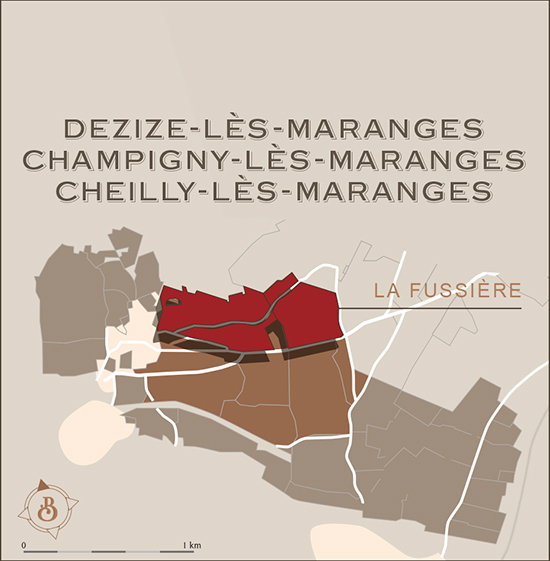Maranges
1er Cru La Fuissière 2017
The Maranges area, forms a link between the Côte-d’Or and the Saône-et-Loire.
Origin
Neighboring the Santenay appellation, the Maranges appellation is located on the southern tip of the Côte de Beaune. Mostly planted in Pinot Noir, the hills forming this vineyard has a south/south-east exposure, with an altitude oscillating between 240 and 400 meters.
"La Fussière", which extends over almost 35 hectares with a beautiful exposure to the south, has a mainly marly soil (gray and blue marls covered with calcareous scree).
The name "Fussière" is derived from the ancient French "Faisse" or "Faissa" which means "land strip". This refers to the terraced winegrowing we find on this steeply slope.
Viticulture
Grape variety: pinot noir
Soils: gray and blue marls covered with calcareous scree.
Orientation: South
Surface area under vine: 0,95 ha
Pruning: Guyot & Cordon de Royat systems
Yield: 40 hL/ha
Average age of the vines: 40 years old.
Vinification
Harvest date: 9,11 & 13 September 2017.
The grapes were sorted a first time in the vineyard and a second time on the sorting table when they arrived at the winery.
At the winery: the grapes were completely destemmed but not crushed (they were left whole) and were gravity-fed into tanks. Maceration lasted a total of 23 days including one week of cold maceration (12°C). Fermentation used indigenous yeasts only (no additives such as enzymes or tannins were used). Infrequent punching of the cap (8 maximum).
Ageing
Maturation: aged on the lees for 10 months with no racking using a proportion of 35% new French oak barrels.
Barrels: French oak barrels that had been toasted at low temperatures for a long time for very delicate oaking.
Bottling
Bottling: in August 2018, the wine was very gently filtered before being bottled using gravity.
Number of bottles: 5,000.
Vintage
2017 , finesse
The growing cycle was thrown off-kilter by a very cold winter, late spring frost, then optimal conditions for rapid flowering, sporadic hail, and summer drought. Harvesting began in early September in the sun, and after several lean years, the vines finally produced abundant grapes, although with significant differences in maturity between whites and reds and from one region to another, which called for strict sorting.
Ageing potential: from 5 to 7 years.
Tasting notes
The ruby color is brilliant. The nose exudes aromas of raspberries and fresh cherries, as well as some notes of sweet spices. On the palate, this wine turns out to be very supple, with moderate tannins and good acidity.



